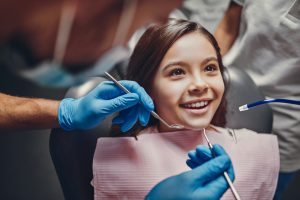Oral Report
 While February is most associated with sending flowers and chocolates on Valentine’s Day and whether Punxsutawney Phil will see his shadow or not, the shortest month on the calendar also has another important meaning. Every year at this time, the American Dental Association sponsors Children’s Dental Health Month, bringing together doctors, other health care providers and educators from across the country to increase awareness and teach children the lifelong benefits of establishing good habits with their teeth.
While February is most associated with sending flowers and chocolates on Valentine’s Day and whether Punxsutawney Phil will see his shadow or not, the shortest month on the calendar also has another important meaning. Every year at this time, the American Dental Association sponsors Children’s Dental Health Month, bringing together doctors, other health care providers and educators from across the country to increase awareness and teach children the lifelong benefits of establishing good habits with their teeth.
In light of that observance, Orlando Family Magazine decided to do its part by checking in with local professionals and finding out more about the significant advancements that have made it easier for families to stay abreast of their children’s oral health and get the help they need when issues arise.
While some doctors feel that not enough progress has been made, others believe the differences in the field are night and day from when they first started.
“There’s no question about it,” says Dr. Breck Brewer of Fravel Brewer Orthodontics. “Certainly, even since I have been in school, things have changed so dramatically as far as digital technology, how we treat patients and the different techniques that we’re able to employ.”
Brewer does not hesitate in singling out the most recent game-changer.
“I would say in orthodontics in particular, probably the biggest change that we’ve had over the past five years, and this applies to children’s dentistry as well as adult dentistry, is the transition to a digital approach,” he says. “The 3D printing has gotten so good that we are able to employ a much more digitized approach to treatment planning—what we want when we see problems in the mouth, how we want to address them and where we want the teeth to go from and to.”
Instead of the goopy impressions of teeth that were used in the past to make models, they can now take virtual scans of the mouth, upload the images to a computer and send them to a lab. “They can create certain types of appliances or devices that we can put in the mouth to correct the bite, help guide the mouth into a new place, expand the jaws—it can really address a number of problems that we see,” Brewer says. “These labs now can even use an approach called sintering, where they’re 3D printing metal appliances, which is really fascinating. You can eliminate a number of steps this way and you have much better control of what the problem is and where you want to see the corrections.”
Brewer says three-dimensional X-rays have also benefited doctors greatly in allowing them better insight into issues in the mouth. Dr. Andre Baptiste of Baptiste Orthodontics agrees that technology has led to important strides.
“Digital X-rays have been a big advancement,” he says. “Not having to develop a film or have the cost associated with taking an X-ray, and being able to send X-rays instantly to other doctors or patients, is a real big thing. Digital scanners are also huge. We don’t take any molds anymore for aligners—it’s all digital now. You get a more accurate image and that image is stored perfectly forever without using any physical storage space.
“In the past we would take a mold, make sure it’s a good one, we’d have to mail it to the aligner company and if it wasn’t good, we wouldn’t find out until a week later. Then we’d have to bring the patient back in, make another impression, mail it again. Now we just send an email and it’s also more accurate than a mold, so we get a better-fitting aligner.”
Speaking of clear aligners like Invisalign or ClearCorrect—which can adjust teeth with trays that are removable for eating or brushing and flossing—Baptiste calls them “the most revolutionary thing we’ve experienced in my practicing career. They’re great for teens and we have a very good compliance rate with our young people—even better than the adults, actually. The adults are probably 90% compliant, but the kids are 95%.”
Clear aligners have been around for quite a while, but Brewer adds that just in the last few years has his practice expanded their use. “At this point, we’re able to treat nearly all cases with an Invisalign aligner if the patients prefers that over braces,” he says. “There are exceptions where braces provide a certain advantage, but Invisalign has a lot of advantages to it: the flexibility of being able to take them out, the ability to brush and floss much easier than with braces and wires, there’s less discomfort because the lips aren’t rubbing up against those rough brackets and you don’t have wires poking you, and there’s fewer emergencies.”
Invisalign Teen is similar to the system that is used for adults, and Brewer says this is an ideal time for treatment because all of the permanent teeth are in but there is still growth occurring with the bone, allowing for easier movement and greater control. Then there’s Invisalign First, which is much more rare but can be used for children between the ages of 7 and 10. The American Association of Orthodontists recommends children see an orthodontist as early as age 7, and while treatment at this time is not common, potential problems may be diagnosed and treatment started in what is called phase one of orthodontics.
“That means there’s enough of a reason to do a little bit of the treatment now to lessen the degree of the problems that we see,” Brewer says. “These are usually specific—the jaw is not lining up, the bite is far enough off to where we realize something needs to be done, or teeth do not have adequate space to come into the mouth. In phase one, sometimes we’re doing partial braces, sometimes we’re doing an expander to widen the mouth. Many times, this can also be done with Invisalign, and this age group—7 to 10 years old—is awesome with Invisalign because they do what they’re told. They have a lot respect for authority and they don’t necessarily argue or forget their trays. They know they’re expected to do it and they do it really well. So we’re able to take that same digital approach and all the advantages of Invisalign and apply it to young age groups, and we’re having really good success with that as well.”
Other professionals, like Dr. Jim Wortham of Wortham Orthodontics, offer Invisalign for children but prefer traditional braces. Advancements have been made in this area as well, allowing for shorter treatment times and fewer trips to the doctor’s office.
“The biggest [advancement] is called self-ligating braces,” Wortham says. “The brace actually holds onto the wire and the wires have a built-in pressure limitation, so there’s not going to be as much pressure on a tooth as there used to be. So the biological response is usually a little bit better and the discomfort, although there is some there, is less than it used to be. It allows us to go longer in between appointments and still get done at the same time, or quicker, so the efficiency is better.”
Wortham is excited to see how traditional braces can get even better. “I would think that there are digital technologies that allow for computer modification to the wires, which will make the treatment go quicker and smoother,” he says. “It’s there currently, it’s just a little cost-prohibitive for the majority of cases at this point. As the technology gets more refined and more businesses get into it, the prices will come down and it will become more usable.”
Baptiste believes another groundbreaking advancement is on the horizon. “Ultimately, I think we’ll be able to use stem cells and regrow teeth,” he says. “I don’t think we’re that far away from putting a tooth bud in and having someone grow a replacement tooth instead of putting an implant in. I think that’s going to be the next big thing in dentistry. It’s the kind of thing that’s already been done in animals so the technology is there, but for it to become common practice is another thing. Maybe 10 years from now we’ll be doing that routinely.”
No matter what new methods or technologies come down the road, Wortham says doctors will have to weigh the risks versus the rewards in adopting the changes.
“I think they enhance [treatment] as you bring them onto your systems and your office,” he says. “But it depends on what kind of orthodontist you are. There are some who are leading edge, they’re constantly trying something new, and they’re going to be the first to get the fun new toys, but their practice constantly has to modify things. I’m probably in the second group who enjoys the new things, but I wait until the sparkle of it is removed a little bit and the bugs have been worked out.
“Then there are orthodontists who resist everything [and say], ‘I do it this way and I’m not going to change at all.’ There are older orthodontists and orthodontists my age who are very happy doing it the same way and it works very well for them. It’s a balance of what you perceive is beneficial to your patients and your practice.”
Pediatric Dental Care Resource Guide
Orthodontics
Baptiste Orthodontics
Apopka: (407) 801-7775
Orlando: (407) 294-1560
Windermere: (407) 217-2927
Fravel Brewer Orthodontics
Ocoee | (407) 656-0001
Garcia Family Orthodontics
Orlando | (407) 857-0800
MyFamily Orthodontics
Orlando | Windermere
(407) 258-3262
Wortham Orthodontics
Clermont: (352) 394-0100
Winter Garden: (407) 654-9555
Pediatric Dentistry
New Pediatric Dental Care of Greater Orlando
Orlando and Oviedo | (407) 208-0288
PediatricDentalCareOrlando.com
Winter Garden Pediatric Smiles
Winter Garden | (407) 614-5955








